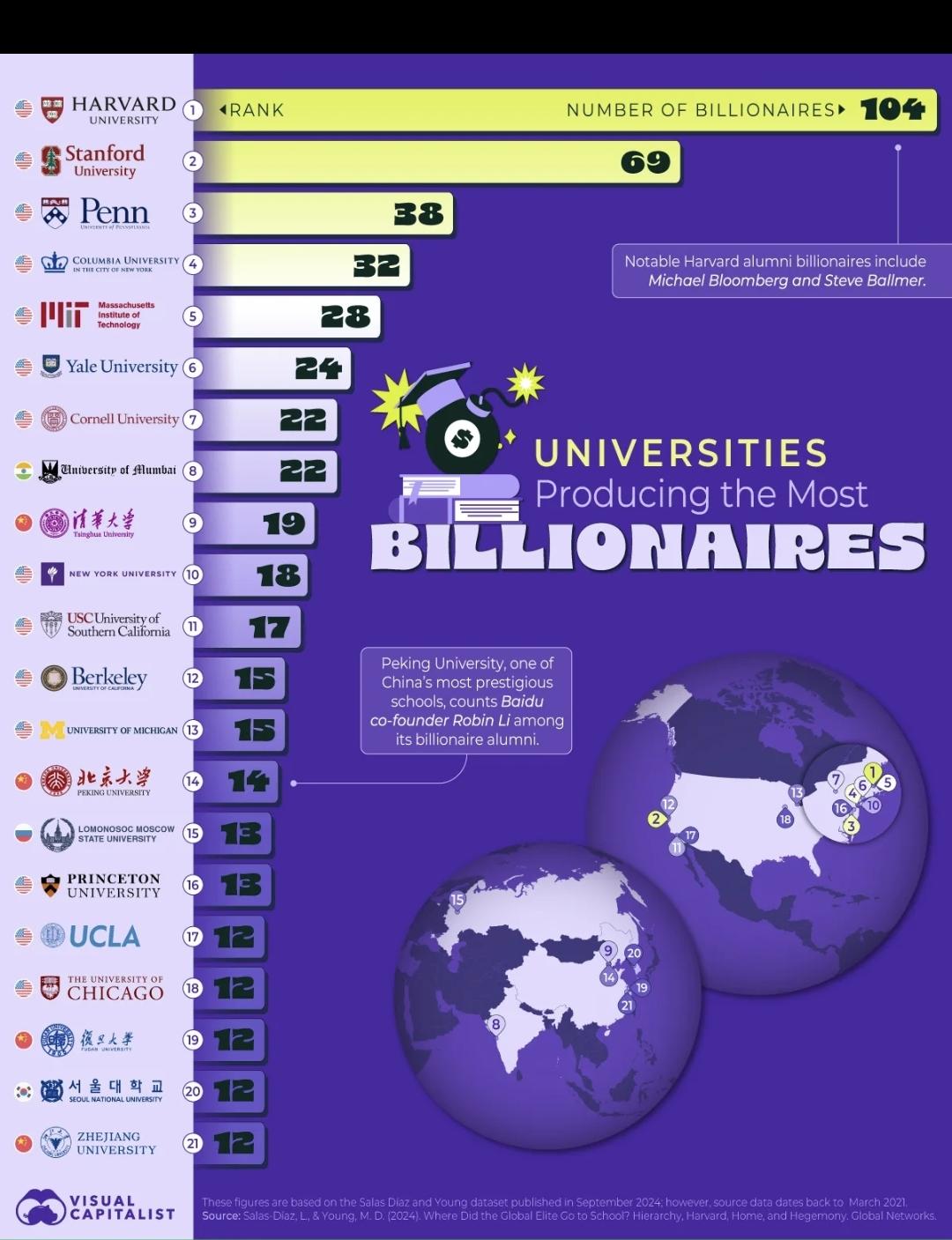Map of Universities Producing the Most Billionaires


David Chen
Data Visualization Specialist
David Chen is an expert in transforming complex geographic datasets into compelling visual narratives. He combines his background in computer science ...
Geographic Analysis
What This Map Shows
The visualization titled "Universities Producing the Most Billionaires" provides a compelling overview of the educational institutions that have produced the highest number of billionaires worldwide. It highlights the link between elite education and wealth accumulation, allowing us to see how certain universities contribute significantly to the billionaire demographic. Interestingly, this map serves as a reflection of social mobility, networking opportunities, and the economic landscape shaped by these institutions.
Deep Dive into Billionaire-Producing Universities
Have you ever wondered what role education plays in the creation of billionaires? The connection is quite significant. Universities often act as incubators for talent and innovation, providing not just knowledge but also vital networking opportunities that can lead to lucrative endeavors. Many of these institutions boast distinguished alumni who have ventured into diverse fields, from technology and finance to entrepreneurship and philanthropy.
For instance, schools like Harvard University and Stanford University consistently rank at the top of this map, showcasing their ability to foster environments where future billionaires can thrive. Harvard alone has produced over 160 billionaires, including notable figures like Mark Zuckerberg and George W. Bush. This is a testament to its extensive resources, renowned faculty, and a curriculum that encourages critical thinking and innovation.
Moreover, Stanford's proximity to Silicon Valley cannot be overlooked. It has become a breeding ground for tech entrepreneurs, many of whom have gone on to create transformative companies. The university's emphasis on entrepreneurship and its strong ties to the venture capital community have positioned it as a vital player in the tech boom of the 21st century.
Interestingly, the influence of these universities extends beyond their immediate geographic locations. They attract top talent from around the globe, creating a rich tapestry of ideas and cultures that enhance innovation. This is particularly evident in the case of the University of Pennsylvania's Wharton School, which has produced numerous billionaires in finance and business sectors. The school's rigorous training in business acumen and economics equips students with the tools to excel in competitive environments, often leading them to financial success.
The socioeconomic backgrounds of students also play a role in this equation. While many billionaires have come from privileged backgrounds, the map also showcases instances of upward mobility where individuals from less affluent families have broken through barriers thanks to the education and opportunities provided by these institutions. This creates a fascinating dynamic in how education, wealth, and societal structures interact.
Regional Analysis
Examining the map further, we can see notable regional trends in billionaire production. For instance, the United States overwhelmingly dominates the billionaire landscape, with a significant concentration of wealth originating from institutions on the East and West Coasts. The Northeast, featuring schools like Columbia University and MIT, contrasts with the West Coast's stronghold, particularly Stanford and UC Berkeley, which focus heavily on technology and innovation.
In contrast, European universities such as the University of Cambridge and the University of Oxford also appear on the map, indicating a more global distribution of billionaire-producing institutions. However, their numbers are notably lower compared to their American counterparts. This could be attributed to different economic structures and cultural attitudes towards wealth and entrepreneurship in Europe.
Interestingly, emerging economies are starting to make their mark as well. Institutions in countries like China, particularly Tsinghua University and Peking University, are gaining recognition for producing billionaires, which reflects the rapid economic growth and increasing opportunities in these regions.
Significance and Impact
Understanding the link between education and the production of billionaires is crucial for several reasons. First, it sheds light on the dynamics of social mobility and the factors that contribute to wealth accumulation. As we analyze these educational institutions, we can better understand the pathways to financial success and the barriers that still exist for many.
Moreover, this topic resonates with current trends in higher education, where the debate around student debt and accessible education is more relevant than ever. The disparity in billionaire production raises questions about economic inequality and the role of elite institutions in perpetuating or alleviating these disparities.
As we look toward the future, it will be interesting to see how the landscape of billionaire-producing universities evolves. Will online education or alternative learning environments reshape this map? Or will traditional universities continue to dominate the field? By keeping an eye on these trends, we can gain valuable insights into the intersection of education, wealth, and societal change.
Visualization Details
- Published
- October 8, 2025
- Views
- 36
Comments
Loading comments...